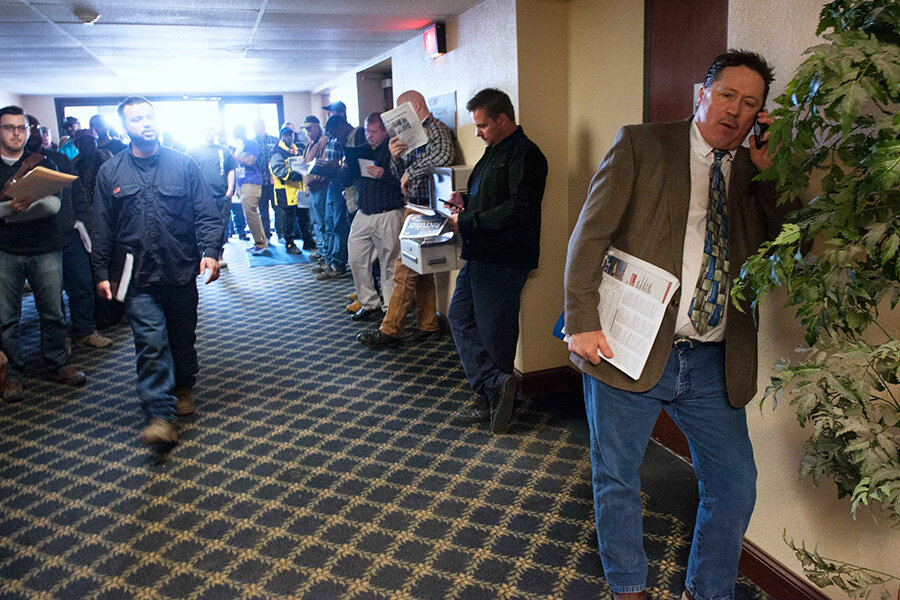Why are more jobs available in the US now than in the last 15 years?
Loading...
| Washington
U.S. employers advertised the most open jobs in April than at any time in the 15 years that the government has tracked the data, a sign that this year's steady hiring will likely continue.
The Labor Department said Tuesday that the number of open jobs at the end of April jumped 5.2 percent to 5.4 million. The figure suggests that employers anticipate stronger customer demand in the months ahead.
The job market has remained healthy even as the economy faltered at the start of 2015. The steady hiring shows that businesses see the economic slump as having resulted mainly from temporary factors such as a harsh winter.
On Friday, the government said employers added a robust 280,000 jobs in May after a healthy gain in April. Average hourly wages also ticked up.
Tuesday's figures show "the bigger than expected gain in employment in May was no fluke," said Paul Ashworth, chief U.S. economist for Capital Economics. "Labor market conditions are strengthening and wage growth will accelerate further."
The unemployment rate rose to 5.5 percent last month, from 5.4 percent. But even that was partly good news: the improving job market and wage gains encouraged more people to start searching for work, reducing the number who had given up the hunt.
The figures reported in last Friday's jobs report are a net figure: Jobs gained minus jobs lost. The data reported Tuesday, in the Job Openings and Labor Turnover survey, are more detailed. They calculate total hires, as well as quits and layoffs. Tuesday's numbers also reflect data for April, and are a month behind last week's jobs report.
While the number of job openings soared, employers are still taking their time filling them. Total hiring in April fell to 5 million from 5.1 million. The disparity between more openings and flat hiring suggests employers are being picky about new hires. Many companies say they are having difficulty finding qualified workers.
They may not be offering high enough wages. Average hourly pay rose just 2.3 percent in April from a year earlier, much lower than the roughly 3.5 percent gains typical in a healthy economy.
Tim Hopper, chief economist at TIAA-CREF, a financial services firm, said the jump in openings is a sign of confidence, even if they are not filled immediately.
"It says companies are getting more optimistic," he said. "It doesn't mean that they are hiring today, it means they anticipate hiring in the future."
Other measures also suggest that business confidence is growing and that is fueling more hiring. The National Federation of Independent Business' small business optimism index rose to 98.3 in May, the highest since December and in line with historical averages.
More small firms are reporting higher sales and profits, the NFIB found, and are adding workers.
More quitting and more total hires can help push up wage gains. That's because people typically quit when they have a new job lined up, usually for higher pay. And when firms move to fill more open jobs, particularly as the unemployment rate declines, they typically have to offer more pay to attract workers.
Quits fell in April to 2.67 million, from 2.77 million, though they remain near pre-recession levels. Quits reached a seven-year high in January.
In April, they rose 11 percent from a year earlier, evidence that many people with jobs are willing to leave them in search of better pay.
Seattle resident David Peters recently left the security of the consulting firm McKinsey to develop growth strategies as the entrepreneur in residence at Porch, a web site and app that helps homeowners find contractors, roofers, plumbers and repairmen.
"I went from something that was fairly conservative to something that was aggressively risky — a startup," Peters said. "I do have a lot more confidence in the overall economy and that allowed me to make that shift."
Federal Reserve chair Janet Yellen has said she closely watches the hiring and quits figures for clues about the jobmarket's health. Fed policymakers will meet next week, and analysts expect they will keep short-term interest rates near zero, where they have been for more than six years.
___
AP Economics Writer Josh Boak contributed to this report.







